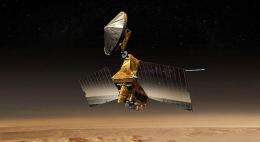NASA's Mars Reconnaissance Orbiter Resumes Observations

(PhysOrg.com) -- Researchers are receiving new science data from NASA's Mars Reconnaissance Orbiter after the spacecraft's six science instruments resumed observations today.
Observations had been suspended since a computer reset Aug. 26. During the time since then, engineers analyzed a series of previous computer resets by the spacecraft and completed preventive care to guard against a vulnerability identified by that analysis.
In addition to the Aug. 26 event, the orbiter had spontaneously reset its computer three times earlier this year: Feb. 23, June 4 and Aug. 6. The mission had returned to full science operations within a few days after the first three. The decreasing intervals between the resets prompted the team to perform a more extensive analysis after the fourth one.
"It's good to have the instruments back on," said Mars Reconnaissance Orbiter Mission Manager Dan Johnston of NASA's Jet Propulsion Laboratory, Pasadena, Calif. "This has been a long stand-down. Now we're ready to resume our science and relay mission."
Engineers have not identified a root cause for the four reset events, but the team has added protections for the spacecraft and expects to obtain more diagnostic information in the event of another reset.
Two weeks ago, engineers rewrote selected files in the orbiter's non-volatile memory, where information is preserved even if a reset interrupts power. This was done to remove a vulnerability that had been identified for an unlikely scenario of two resets within a minute of each other. On Dec. 8, engineers commanded the orbiter out of the precautionary, minimum-activity status called "safe mode" that they had kept it in since August. Additional steps, including a change of spacecraft orientation to point the instruments downward at Mars, enabled the spacecraft's science instruments to resume observations.
"The orbiter's six instruments will continue examining the atmosphere, surface and subsurface of Mars, including areas of interest as potential landing sites for future missions," said JPL's Rich Zurek, Mars Reconnaissance Orbiter project scientist. "It is northern spring in the northern hemisphere on Mars, and we are eager to take advantage of the good visibility provided by the relatively dust-free atmosphere present at this season. A major goal of the mission is to look at changes on Mars. For example, the instruments will observe the changing polar caps, examining the extent and composition of the retreating north polar frosts and the growth of the south polar cap during this period."
Launched Aug. 12, 2005, the orbiter reached Mars the following year to begin a two-year primary science phase that was completed last year. It has returned more data about Mars than all other spacecraft combined. Its findings indicate a complex Martian history of climate change that produced a diversity of past watery environments over hundreds of millions of years.
The Mars Reconnaissance Orbiter remains an important asset for exploring Mars and serving as a communications relay for spacecraft on the planet's surface. NASA's other active Mars orbiter, Mars Odyssey, was also briefly in safe mode for a portion of last week, but has also resumed relay and science operations.
Provided by JPL/NASA




















